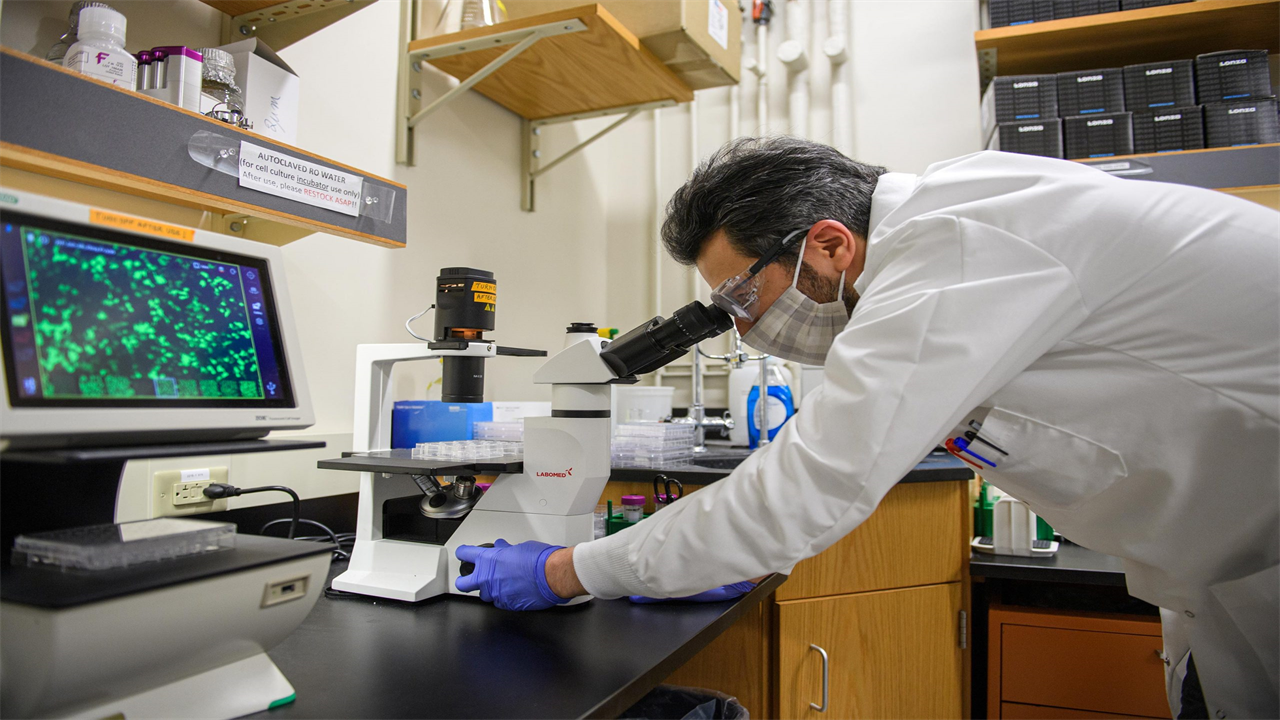COVID-19 Causes “Unexpected” Cellular Response in the Lungs, Surprising Scientists
0 View
Share this Video
- Publish Date:
- 20 April, 2021
- Category:
- Covid
- Video License
- Standard License
- Imported From:
- Youtube
Tags

Scientists have discovered a surprising response in lung cells infected with the SARS-CoV-2 virus, which could explain why the disease is so difficult to treat. “This was completely unexpected,” said Purdue scientist Majid Kazemian, who led the study. The researchers propose to test a new combination of drugs to fight the disease. Credit: Photo by Purdue University / Rebecca McElhoe
New insights into the immune response to SARS-CoV-2 infections may lead to better treatments for COVID-19 cases.
An international team of researchers unexpectedly discovered that a biochemical pathway known as the immune complement system is activated in lung cells by the virus, which could explain why the disease is so difficult to treat. The research is published in the journal Science Immunology.
The researchers propose that combining antivirals with drugs that inhibit this process may be more effective. Using an in vitro model with human lung cells, they discovered that the antiviral drug Remdesivir, in combination with the drug Ruxolitinib, inhibited this complement response.
This is despite recent evidence that studies using Ruxolitinib alone for the treatment of COVID-19 have not been promising.
To identify potential drug targets, Majid Kazemian, assistant professor in the departments of computer science and biochemistry at Purdue University, said the research team examined more than 1,600 previously FDA-approved drugs with known targets.
“We looked at the genes that are up-regulated by COVID-19 but down-regulated by specific drugs, and Ruxolitinib was the best drug with that property,” he said.
In recent years, scientists have discovered that the immune complement system – a complex system of small proteins produced by the liver that support or replenish the body’s antibodies in the fight against blood-borne pathogens – can work in cells, not just the bloodstream.
Surprisingly, the study found that this response is triggered in cells of the small structures in the lungs known as alveoli, Kazemian said.
“We found that SARS-CoV2 infection of these lung cells causes the expression of an activated complement system in an unprecedented way,” said Kazemian. “This was completely unexpected for us because we were not thinking about activating this system in the cells, or at least not about the lung cells. We usually think of the complement source as the liver. “
Claudia Kemper, senior researcher and head of the Complement and Inflammation Research division at the National Institutes of Health, was one of the first to characterize new roles of the complement system in the immune system. She agreed that these latest findings are surprising.
“The complement system has traditionally been thought of as a liver-derived and blood-circulating sentinel system that protects the host from infections by bacteria, fungi and viruses,” she said. “It is unexpected that in the setting of SARS-CoV2 infection, this system is more likely to turn against the host and contribute to the noxious tissue inflammation seen in severe COVID-19. We need to consider modulation of this intracellular, local complement in combating COVID-19. “
Dr. Ben Afzali, an Earl Stadtman researcher at the National Institute of Health’s National Institute of Diabetes and Digestive and Kidney Diseases, said there is now evidence that this has implications for problems in the treatment of COVID-19.
“These findings provide important evidence showing not only that complement-related genes are among the major pathways induced by SARS-CoV2 in infected cells, but also that complement activation takes place in the epithelial cells of the lung, ie locally where infection is present, ” he said.
“This could explain why targeting the complement system outside the cells and in the circulation was generally disappointing in COVID-19. We should probably consider using inhibitors of complement gene transcription or complement protein activation that are cell permeable and act intracellular instead. “
Afzali cautions that appropriate clinical studies should be conducted to determine whether a combination treatment provides a survival benefit.
“The second finding that I believe is important is that the data suggests a potential benefit for patients with severe COVID-19 from the combinatorial use of an antiviral agent in conjunction with an agent that broadly targets complement production or activation in infected cells,” ” he said. “These data are promising, but it is important to recognize that we have conducted drug therapy experiments in cell lines infected with SARS-CoV2. So by themselves they should not be used to direct the treatment of patients. “
Kemper added that the unexpected findings raise more questions.
“A currently unexplored and potentially therapeutically interesting aspect of our observations is also whether the virus uses local complement generation and activation to its advantage, for example, for the processes underlying cell infection and replication,” she said.
Reference: “SARS-CoV-2 Stimulates JAK1 / 2 Dependent Hyperactivation of Local Complements” by Bingyu Yan, Tilo Freiwald, Daniel Chauss, Luopin Wang, Erin West, Carmen Mirabelli, Charles J Zhang, Eva-Maria Nichols, Nazish Malik, Richard Gregory, Marcus Bantscheff, Sonja Ghidelli-Disse, Martin Kolev, Tristan Frum, Jason R Spence, Jonathan Z. Sexton, Konstantinos D. Alysandratos, Darrell N. Kotton, Stefania Pittaluga, Jack Bibby, Nathalie Niyonzima, Matthew R Olson, Shahram Kordasti, Didier Portilla, Christiane E Wobus, Arian Laurence, Michail S Lionakis, Claudia Kemper, Behdad Afzali and Majid Kazemian, April 7, 2021, Science Immunology.
DOI: 10.1126 / sciimmunol.abg0833










